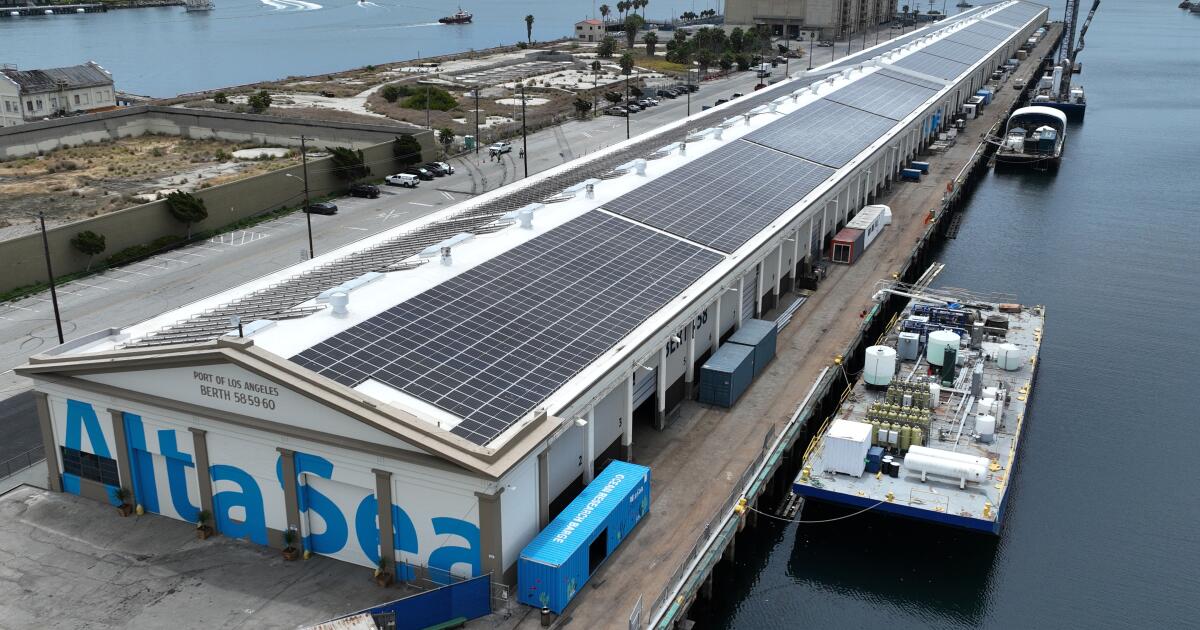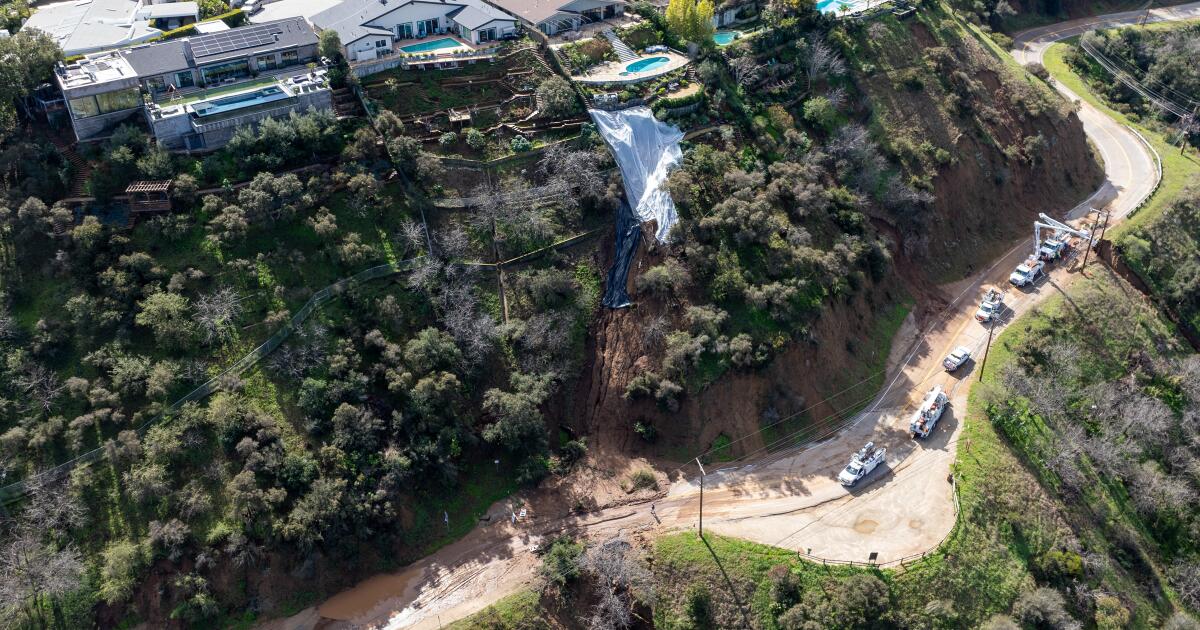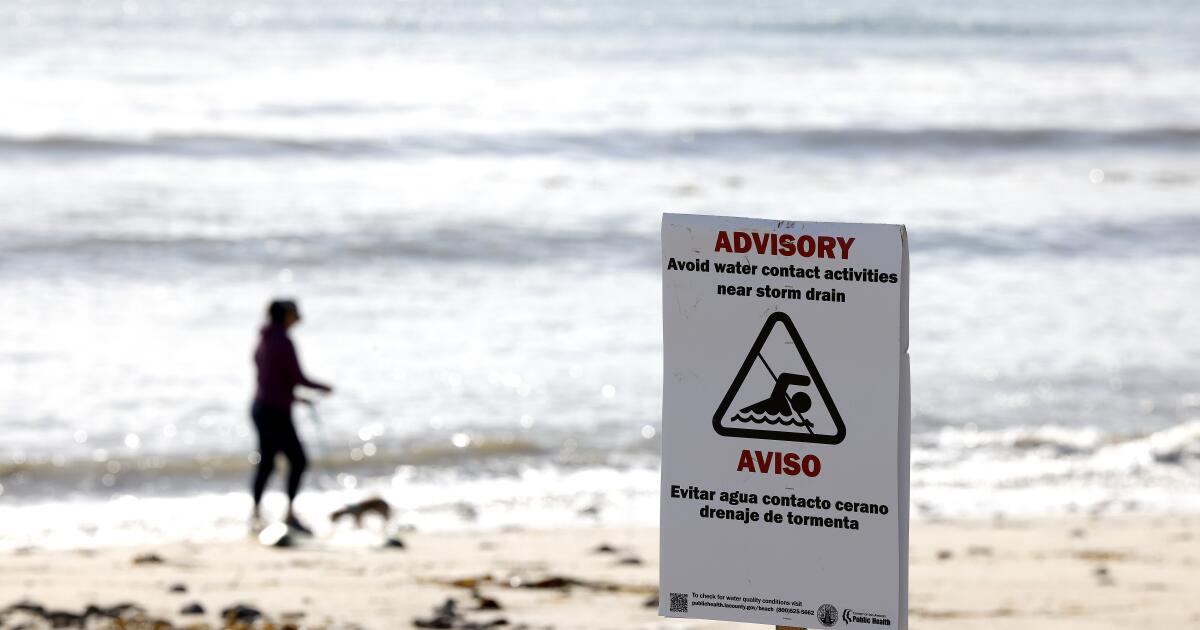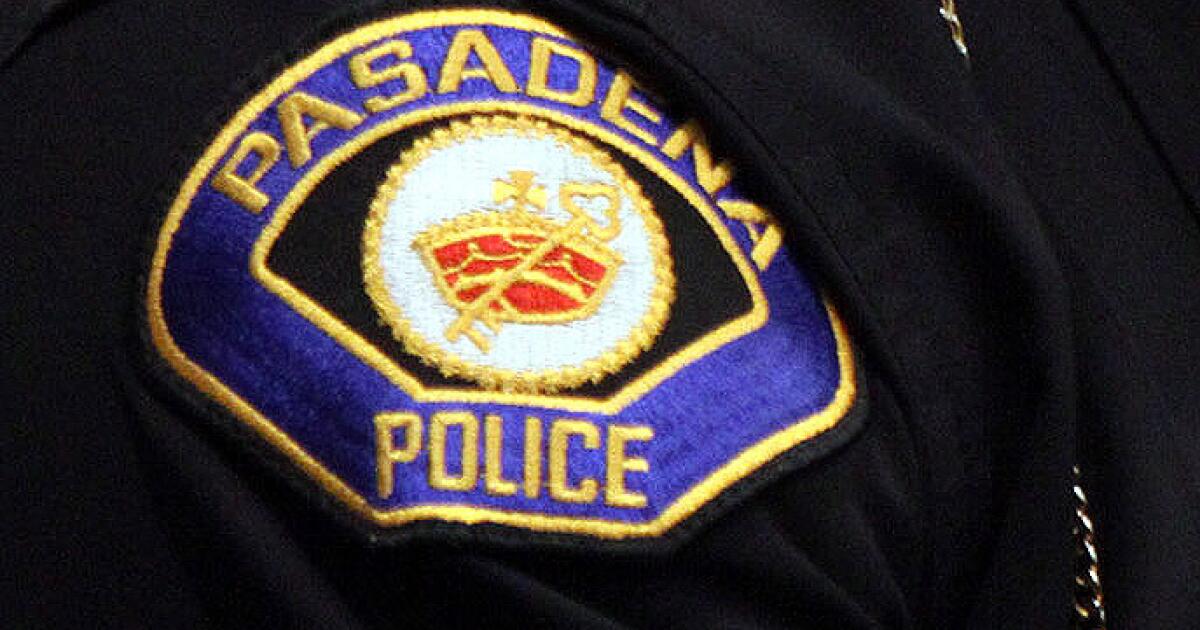World News
Why isn’t it easier to install a heat pump in California?

The nation’s electric utilities have voiced overwhelming support for reducing carbon emissions. Eighty percent of U.S. electricity customers are served by a utility with a 100% carbon-reduction target, according to the Smart Electric Power Alliance, and utility executives have touted their sustainability plans at the U.N. Climate Conference, Davos and beyond.
So why is it so hard to get help switching to a climate-friendly heat pump?
Marvels of modern engineering, heat pumps provide heating and cooling by transferring warm or cold air into or out of a home, eliminating the need to generate heat. They have been shown to substantially slash consumer heating costs and cut greenhouse gas emissions up to 50%.
Like so many other Americans who helped fuel a residential construction boom following the onset of the pandemic, I recently embarked on a wholesale remodel of my home in the Bay Area. Unlike most of my fellow remodelers, I make my living analyzing trends in customer experience with the nation’s electric, gas and water utilities. As an energy nerd, I saw the project as a chance to delve into the various incentives that the utilities have been promoting to facilitate my conversion from a gas-fired furnace to an electric heat pump.
What I found was a tangle of red tape, well-meaning but tragically ill-informed customer service representatives, and hours upon hours of filing forms, chasing down obscure information and questioning contractors — all in a quixotic quest to claim my local, state and federal rebates.
Heat pumps loom large as a component of electric utility sustainability initiatives. The Biden administration recently announced that $63 million in Inflation Reduction Act funding would be used to spur domestic manufacturing of heat pumps, and local, state and federal incentives have been deployed in most jurisdictions nationwide to encourage consumers to make the switch.
At the federal level, consumers are eligible for a tax credit that covers 30% of the cost of buying and installing a heat pump, up to a maximum of $2,000 per year. The TECH Clean California program offers incentives to contractors to install heat pumps, and the Los Angeles Department of Water & Power and other utilities offer rebates and other benefits. In Marin County, where I live, state, county and local incentives promised to bring the total rebate on my project to almost $5,000.
That prospect, along with the long-term value of increased efficiency, was enough to persuade me to take the plunge on a system that was a bit more expensive than a comparable gas furnace. Moreover, my extensive research on the subject was enough to overcome widespread misconceptions about the technology and its ability to comfortably heat and cool my home.
The good news is that my heat pump works wonderfully! It’s so good that I’ve started recommending one to my friends and neighbors. It isn’t loud or dry like traditional heat; it’s even and smooth. The system allowed much more flexibility in our construction and design. And, best of all, I now have central cooling for the first time.
Unfortunately, I’ve also put hours of work into chasing rebates I still haven’t received.
Ironically, the easiest part of the process was applying for a federal rebate through the Internal Revenue Service. When the IRS sets the benchmark for customer service, you know you have a problem.
Among the challenges I faced were an hour-plus conversation with a friendly Pacific Gas & Electric Co. representative who knew absolutely nothing about heat pump programs; an apologetic county official who informed me that I would need to fill out a commercial form even though my project was residential because “that’s the way the paperwork is written”; and even a request to provide detailed photos of my old gas furnace — the one that had already been removed — to prove I had made the switch.
Fortunately, because I was documenting the process partly for my own education, I had those photos and welcomed the opportunity to find all the hurdles consumers face. But will typical consumers — those who don’t spend their workdays analyzing the minutiae of utility customer experience — even bother to deal with this craziness? Probably not.
Perhaps that has something to do with the widespread customer apathy toward electric utility sustainability efforts. J.D. Power’s most recent study of this topic found that just 19% of customers were even aware of their utility’s carbon reduction initiatives.
We’re living in an era of amazing technological innovation, and we have public policies designed to catalyze consumer adoption of these breakthroughs. But if the same old bureaucratic hurdles stand in the way of access to those programs, no one wins.
There is a huge opportunity here for innovative utilities to take the lead on improving not only our policies but also the mechanisms that make them work. As a utilities industry professional, I’m optimistic that our leaders will take up this cause. As a consumer, I just hope I eventually get my rebate.
Andrew Heath is the vice president of utilities intelligence at J.D. Power.
World News
Damaging Winds and ‘Very Large Hail’ Hit Central Texas

Grant Cruise, a spokesman for Oncor, a Texas electricity provider, said at a news conference that crews were assessing the damage on Tuesday. He said the response was more a matter of “complete reconstruction” rather than the simple repair of downed power lines.
“We are asking for your patience,” he said.
Heath Montgomery, a spokesman for Dallas Fort Worth International Airport, said that the Federal Aviation Administration grounded flights there from 5:30 a.m. to 8 a.m. About 90 flights were canceled for the day, and a number of flights were diverted to other airports, he said.
Beyond Texas, Kentucky is expecting a reprieve in the coming days, as the National Guard and forestry workers continue to clear downed trees and dangerous debris from powerful storms that killed four people over the weekend. The Weather Service in Louisville said that mostly dry weather was expected in the coming days, with no rain in the forecast until the weekend.
Severe storms were possible across Central Oklahoma on Tuesday, beginning early in the morning and shifting south through the afternoon, according to the Weather Service office in Norman, Okla. In Southern Oklahoma, raging storms with large hail had become less intense by early Tuesday morning, the Weather Service said. Still, hail the size of golf balls and damaging winds of up to 60 m.p.h. were possible later in the day. Two people were killed north of Tulsa over the weekend as severe storms swept in.
After a wet, windy and disruptive Memorial Day in the Mid-Atlantic and Northeast, sunny, summerlike conditions returned on Tuesday morning with highs in the low-to-mid 80s.
There were 2,000 delays and 300 cancellations of flights into, within or out of the United States on Tuesday, according to FlightAware, a flight tracking website. On Friday, more than 2.9 million people were screened at U.S. airports, the Transportation Security Administration said, a single-day record.
Christine Hauser and Ernesto Londoño contributed reporting.
World News
Man jailed for attempted murder of pregnant ex

 Wales News Service
Wales News ServiceA man has been jailed 17 years and four months for stabbing his heavily pregnant ex-girlfriend in a street attack.
Daniel Popescu, of no fixed address, pleaded guilty to attempting to murder Andreea Pintili in Aberfan, Merthyr Tydfil, on 5 December 2023.
The 29-year-old also admitted stalking offences.
Prosecutor John Hipkin KC told the court Popescu had been in a relationship with Ms Pintilli from September 2020 until it ended in August 2023 over his gambling habit.
He became obsessed with his ex-girlfriend and, on 27 October, followed her and her son, took a picture of the pair and posted it on TikTok.
Days later he left his clothes in two black bags on her doorstep and left a voicemail message saying: “I’m not going anywhere until you get back with me.”
Popescu was then arrested and told to not contact Ms Pintilli, who moved moved to Aberfan after the incident.
 Andreea Pintili
Andreea PintiliOn 5 December, Ms Pintelli heard footsteps behind her after leaving home at 07:45.
She was grabbed and then stabbed a number of times by Popescu with an 8-inch (20cm) knife.
The court heard her instinct was to protect her unborn child – she was 37 weeks pregnant at the time.
Popescu told her: “I have a knife and I am going to kill you.”
 PA Media
PA MediaThe court was shown CCTV of the incident which included screams from a passer-by who ran over and tried to stop Popescu, who then fled the scene.
Popescu was described by Ms Pintilli as a jealous man who could not face the fact they had split up.
In her victim personal statement read to the court she said: “I feel lucky to be alive after this harrowing experience.
“He told me he had a knife and to get into the house. I have no doubt if I went in to the house he would have killed me.
“His intention that day was to kill me and my unborn child.”
World News
COVID rise in California: How to protect yourself from FLiRT
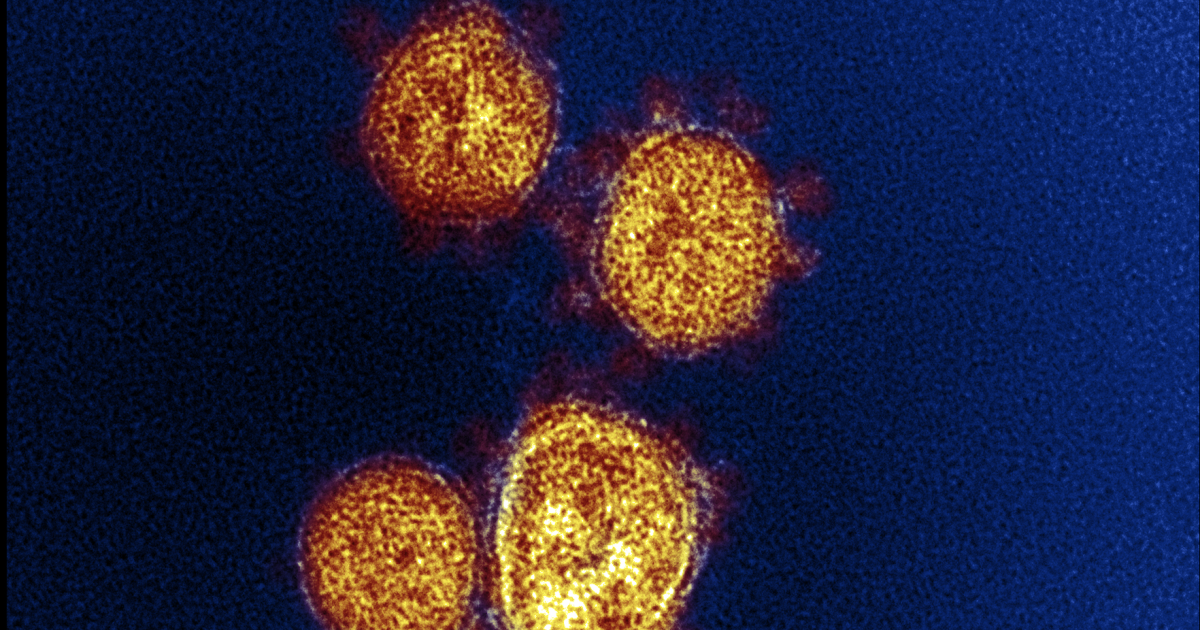
There are growing signs of an uptick in COVID-19 in California thanks to the new FLiRT subvariants.
It’s far too early to know if FLiRT will be a major change in the COVID picture, and so far the impacts have been small.
But health officials are taking note and are urging Californians — especially those at risk — to be prepared.
Here’s rundown of what we know and how you can protect yourself.
What are FLiRT subvariants?
The FLiRT subvariants — officially known as KP.2, KP.3 and KP.1.1 — have overtaken the dominant winter variant, JN.1. For the two-week period that ended Saturday, they were estimated to account for a combined 50.4% of the nation’s coronavirus infections, up from 20% a month earlier.
Despite their increased transmissibility, the new mutations don’t appear to result in more severe disease. And the vaccine is expected to continue working well, given the new subvariants are only slightly different from the winter version.
“It’s been quite a while since we’ve had a new dominant variant in the U.S.,” Dr. David Bronstein, an infectious diseases specialist at Kaiser Permanente Southern California told The Times earlier this month. “With each of these variants that takes over from the one before it, we do see increased transmissibility — it’s easier to spread from person to person. So, that’s really the concern with FLiRT.”
What are officials seeing?
Doctors say they are not seeing a dramatic jump in severely ill people, and COVID levels still remain relatively low. But there are signs of a rise in infections that could lead to the summer coronavirus season beginning earlier than expected.
“COVID-19 concentrations in wastewater have suggested increases in several regions across California since early May. Test positivity for COVID-19 has been slowly increasing since May,” the state Department of Public Health said in a statement to The Times on Friday.
Over the seven-day period that ended Monday, about 3.8% of COVID-19 tests in California came back positive; in late April, that share was 1.9%. (Last summer’s peak test-positive rate was 12.8%, at the end of August.)
In San Francisco, infectious disease doctors are noticing more people in the hospital with COVID-caused pneumonia.
The Los Angeles County Department of Public Health has also started to see a very small uptick in cases in recent days. And Kaiser Permanente Southern California is reporting a small increase in outpatient COVID-19 cases.
How can I protect myself?
Vaccines
Doctors urged people to consider getting up to date on their vaccinations — particularly if they are at higher risk of severe complications from COVID-19.
In California, just 36% of seniors ages 65 and older have received the updated COVID-19 vaccine that first became available in September. The U.S. Centers for Disease Control and Prevention has urged everyone ages 6 months and older to get one dose of the updated vaccine. A second dose is also recommended for those ages 65 and older, as long as at least four months have passed since their last shot.
It’s especially important that older people get at least one updated dose. Of the patients he has seen recently who had serious COVID, said UC San Francisco infectious diseases specialist Dr. Peter Chin-Hong, all of them hadn’t gotten an updated vaccine since September, and were older or immunocompromised.
Behavior
Avoid sick people. Some sick people might pass off their symptoms as a “cold,” when it could be the start of a COVID-19 illness.
Testing
Test if you’re sick, and test daily. It’s sometimes taking longer after the onset of illness for a COVID-19 rapid test to show up as positive. Consider taking a rapid COVID test once a day for three to five consecutive days after the onset of cough-and-cold symptoms, said Dr. Elizabeth Hudson, regional chief of infectious disease at Kaiser Permanente Southern California. Doing so can help the sickened person take measures to later isolate themselves and limit spread of the illness to others.
Planning
Have a plan to ask for Paxlovid if you become ill. Paxlovid is an antiviral drug that, when taken by people at risk for severe COVID-19 who have mild-to-moderate illness, reduces the risk of hospitalization and death.
Masks are much less common these days but can still be a handy tool to prevent infection. Wearing a mask on a crowded flight where there are coughing people nearby can help reduce the risk of infection.
How can I protect my family and friends?
The U.S. Centers for Disease Control and Prevention has recently eased COVID isolation guidance, given that the health impacts of COVID-19 are lower than they once were, due to the availability of vaccines, anti-COVID medicines such as Paxlovid and increased population immunity.
There are fewer people getting hospitalized and dying, and fewer reports of complications such as multi-inflammatory syndrome in children.
Still, doctors say it remains prudent to take common sense steps to avoid illness and spreading the disease to others, given that COVID still causes significant health burdens that remain worse than the flu. Nationally, since the start of October, more than 43,000 people have died of COVID; by contrast, flu has resulted in an estimated 25,000 fatalities over the same time period.
While the prevalence of long COVID has been going down, long COVID can still be a risk any time someone gets COVID.
Here’s a guide on what to do if you get COVID-19:
Stay home and away from others while sick, plus a day after you’ve recovered
The CDC says people should stay home and away from others in their household until at least 24 hours after their respiratory viral symptoms are getting better overall, and they have not had a fever (and are not using fever-reducing medicine). Previously, the CDC suggested people with COVID isolate for at least five days, and take additional precautions for a few more days.
In terms of deciding when symptoms are getting better overall, what’s most important is “the overall sense of feeling better and the ability to resume activities,” the CDC says. A lingering cough by itself can last beyond when someone is contagious, the CDC said.
The Los Angeles County Department of Public Health also recommends testing yourself using a rapid test, and getting a negative result, before leaving isolation.
The agency also suggests staying away from the elderly and immunocompromised people for 10 days after you start to feel sick.
Take additional precautions after you recover in case you’re still contagious
People who have recovered from COVID-19 may still be contagious a few days after they have recovered. The CDC suggests taking added precautions for five days after they leave their household and resume spending time with others to keep others safe. They include:
- Wearing a well-fitting mask;
- Continuing to test for COVID-19. If positive, it’s likely you’re more likely to infect others, still;
- Keeping distance from other people;
- Increasing air circulation by opening windows, turning on air purifiers, gathering outdoors if meeting with people;
- And sticking with enhanced hygiene: washing and sanitizing hands often, cleaning high-touch surfaces, and covering coughs and sneezes.
Masking for 10 days to protect others
The L.A. County Department of Public Health says people with COVID-19 need to wear a well-fitting mask for 10 days after starting to feel sick, even if signs of illness are improving, to reduce the chance that other people could get infected. Masks can be removed sooner if you have two consecutive negative test results at least one day apart, the agency says.
Be aware of COVID rebound
COVID rebound can occur when people with COVID-19 feel better, but then start to feel sick two to eight days after they’ve recovered. Some people may also test positive again. COVID rebound can result in you becoming infectious again, capable of infecting those with whom you interact.
Rebound can happen whether or not you take Paxlovid.
Officials say if you feel sick again after having recovered from COVID, go back to following the same instructions to stay at home and away from other people during the first phase of the illness.
If you test positive but have no symptoms
The CDC says if you never had any symptoms, but test positive, take additional precautions for the next five days, such as masking up, testing, increasing air circulation, keeping distance and washing hands often.
The L.A. County Department of Public Health recommends wearing a well-fitting mask for 10 days after testing positive for COVID-19, and also avoiding contact with any high-risk people for 10 days after starting to feel sick, such as the elderly and immunocompromised people. You can remove your mask sooner if you have two consecutive negative tests at least one day apart.
L.A. County health officials recommend close contacts of people who have COVID-19 wear a well-fitting mask around other people for 10 days after their last exposure. They suggest getting tested three to five days after their last exposure.
-

 African History4 months ago
African History4 months agoBlack History Facts I had to Learn on My Own pt.6 📜
-

 African History4 years ago
African History4 years agoA Closer Look: Afro-Mexicans 🇲🇽
-

 African History4 years ago
African History4 years agoA Closer Look: Afro-Mexicans 🇲🇽
-

 African History1 year ago
African History1 year agoPROOF AFRICAN AMERICANS AIN'T FROM AFRICA DOCUMENTED EVIDENCE
-

 African History2 years ago
African History2 years agoHow Did Normal Medieval People Survive Winter? | Tudor Monastery Farm | Chronicle
-

 African History3 months ago
African History3 months agoMr Incredible Becoming Canny/Uncanny Mapping (You live in Paraguay 🇵🇾)
-

 African History3 years ago
African History3 years agoThe Entire History of Africa in Under 10 Minutes – Documentary
-

 African History3 years ago
African History3 years agoWhat happened to the many African Kingdoms? History of Africa 1500-1800 Documentary 1/6


